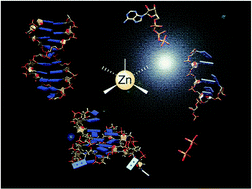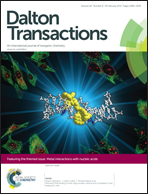Zinc complexes as fluorescent chemosensors for nucleic acids: new perspectives for a “boring” element
Abstract
Zinc(II) complexes are effective and selective nucleic acid-binders and strongly fluorescent molecules in the low energy range, from the visible to the near infrared. These two properties have often been exploited to quantitatively detect nucleic acids in biological samples, in both in vitro and in vivo models. In particular, the fluorescent emission of several zinc(II) complexes is drastically enhanced or quenched by the binding to nucleic acids and/or upon visible light exposure, in a different fashion in bulk solution and when bound to DNA. The twofold objective of this perspective is (1) to review recent utilisations of zinc(II) complexes as selective fluorescent probes for nucleic acids and (2) to highlight their novel potential applications as diagnostic tools based on their photophysical properties.

- This article is part of the themed collection: Metal Interactions with Nucleic Acids


 Please wait while we load your content...
Please wait while we load your content...